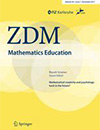
Freiman, V., Polotskaia, E., & Savard, A. (2017). Using a computer-based learning task to promote work on mathematical relationships in the context of word problems in early grades. ZDM Mathematics Education, 0(0), 1–15. https://doi.org/10.1007/s11858-017-0883-3
Abstract: In Canada, as in other Western countries, solving word problems has comprised an important part of mathematics curricula. Traditionally, arithmetic thinking has largely been privileged as the main strategy to solving word problems at the elementary level thus postponing the introduction of algebraic thinking to the secondary school. Drawing on the work of the Russian psychologist Davydov, we suggest that algebraic ways of thinking can be fostered as early as primary grades within the context of problem solving thus enabling understanding of relational aspects of a problem’s mathematical structure. In particular, we used Elkonin and Davydov’s notion of learning activity to design a computer-based task that helps young students (ages 7-8) to analyse word problems and eventually engage in an algebraic way of thinking. The task also involves a whole-class discussion where students probe their understanding of the problem and model its solution in a relational way, instead of instantly locking themselves into a numerical operation. Macro- and micro-levels of analyses were conducted using, inter alia, the lens of the didactical tetrahedron, which highlights the association between design of learning tasks and students’ capacity building in analysing and expressing relationships between quantities through non-numerical symbols. While further research of the relational approach is still in need, this paper demonstrates its potential to contribute to progressively shifting young children’s understanding from one that relies heavily on arithmetic processes toward one that builds on algebraic thinking.



